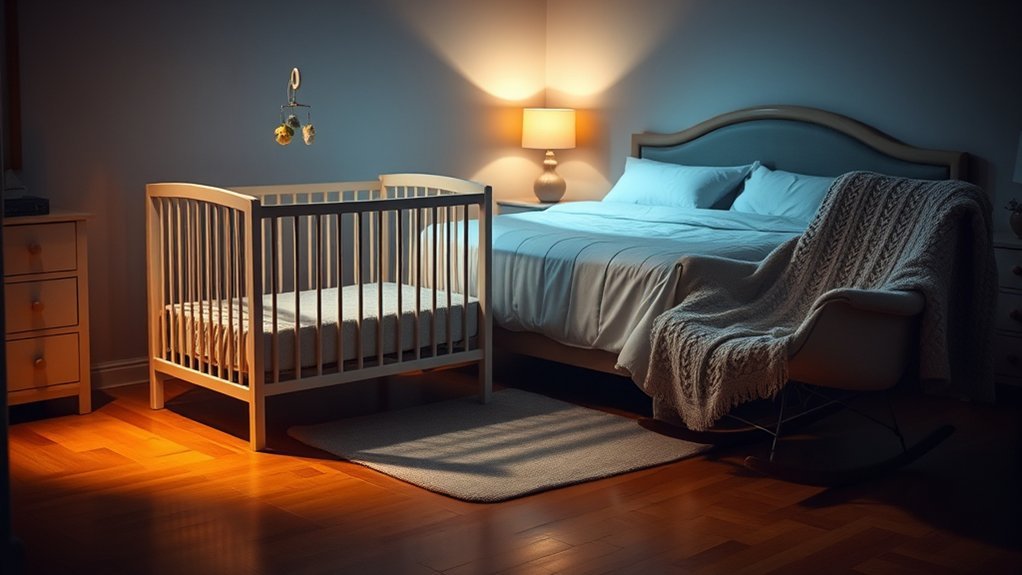When it comes to sleeping arrangements, you might find yourself weighing the pros and cons of co-sleeping versus separate spaces. Each choice can greatly influence your sleep quality, intimacy, and overall parenting effectiveness. While co-sleeping can create a sense of closeness, it often leads to fatigue. On the other hand, separate spaces can foster independence but may come with their own challenges. Understanding these dynamics is essential as you navigate your family’s unique needs. What factors will shape your decision?
The Impact of Co-Sleeping on Family Dynamics
While co-sleeping can foster a sense of closeness, it also introduces complexities into family dynamics that parents must navigate. You might find that sharing a bed with your child creates intimacy, but it can also strain your relationship with your partner. Sleep disruptions often arise, leading to fatigue and irritability. Additionally, the blurred boundaries may challenge your child’s independence, making it harder for them to develop self-soothing skills. You’ll need to reflect on your own comfort and the importance of personal space in your partnership. Balancing the emotional benefits of co-sleeping with the potential challenges is essential, as it impacts not just your sleep, but the overall harmony within your family. Open communication about these dynamics is critical.
Benefits of Separate Sleeping Spaces for Children
Creating separate sleeping spaces for children can considerably enhance their development and foster a sense of independence. When kids have their own space, they learn to self-soothe and develop better sleep habits. This autonomy boosts their confidence and helps them progress into adulthood more smoothly. Additionally, separate sleeping arrangements reduce nighttime disruptions, allowing for deeper, more restorative sleep for both you and your child. It also creates a safe zone for children to explore their imagination and express their individuality. As they learn to navigate their environment independently, you’ll likely notice improvements in their emotional resilience and problem-solving skills. Overall, separate sleeping spaces not only benefit your child’s growth but also contribute to a healthier family dynamic.
Balancing Parental Sleep Needs With Child Care
As you navigate the demands of parenting, finding a balance between your sleep needs and the responsibilities of child care can feel overwhelming. Prioritizing your sleep isn’t selfish; it’s crucial for your well-being and your ability to care for your child. Establishing a consistent bedtime routine can help set boundaries for both you and your child, allowing you to recharge. Consider sharing nighttime responsibilities with your partner or arranging childcare during critical rest periods. Communicating your sleep needs to family and friends can also foster a supportive environment. Remember, when you’re well-rested, you’re more patient and attentive, ultimately benefiting your child’s development. Balancing sleep with child care is a continuous process, but it’s essential for sustaining a healthy family dynamic.
Cultural Perspectives on Sleeping Arrangements
How do cultural beliefs shape the sleeping arrangements of families around the world? In many cultures, co-sleeping is the norm, fostering closeness and security. For instance, in some Asian and African societies, children often share beds with parents well into adolescence. This practice reflects a belief in communal living, emphasizing family bonds over individual space. In contrast, Western cultures tend to promote independence, encouraging children to sleep in their own rooms from an early age. These differing perspectives impact not just sleep quality but also emotional development. Understanding these cultural nuances can help you navigate your own family’s sleeping arrangements, recognizing that there’s no one-size-fits-all approach—what works for one family may not resonate with another.
Tips for Transitioning Between Sleeping Setups
When shifting between sleeping setups, it’s essential to approach the change with patience and understanding. Adjusting can disrupt routines, so consider these tips to ease the process:
| Tip | Explanation |
|---|---|
| Communicate Clearly | Discuss the changes with your child. |
| Introduce Gradually | Make small adjustments over time. |
| Create a Routine | Establish a consistent bedtime routine. |
| Offer Comfort Items | Allow familiar objects to ease anxiety. |
| Celebrate Success | Acknowledge and praise your child’s adaptation. |
Frequently Asked Questions
What Age Is Appropriate for Children to Sleep Alone?
Most children can start sleeping alone between ages 6 and 8, but readiness varies. You should consider their emotional maturity, comfort level, and any fears. Gradual changes help create a positive experience for them.
How Can Sleeping Arrangements Affect Children’s Development?
Sleeping arrangements shape children’s emotional security and independence. While sharing a bed fosters closeness, sleeping alone can boost confidence. Striking a balance lets you nurture their growth while ensuring they feel safe and supported.
Are There Health Risks Associated With Co-Sleeping?
Yes, co-sleeping can pose health risks, including suffocation, overheating, and increased likelihood of sleep disorders. It’s crucial to weigh these risks against the benefits and consider safe practices to protect your child’s well-being.
How Do Sleeping Arrangements Influence Parental Stress Levels?
Sleeping arrangements can markedly influence your stress levels as a parent. When kids sleep nearby, you might feel more anxious about safety or disruptions, but this closeness can also foster emotional connection and reassurance.
What Are Common Myths About Co-Sleeping?
Co-sleeping myths include the belief it creates dependency, increases SIDS risk, or disrupts sleep. In reality, many families find it fosters bonding, enhances breastfeeding, and can actually promote better sleep for both parents and children.
